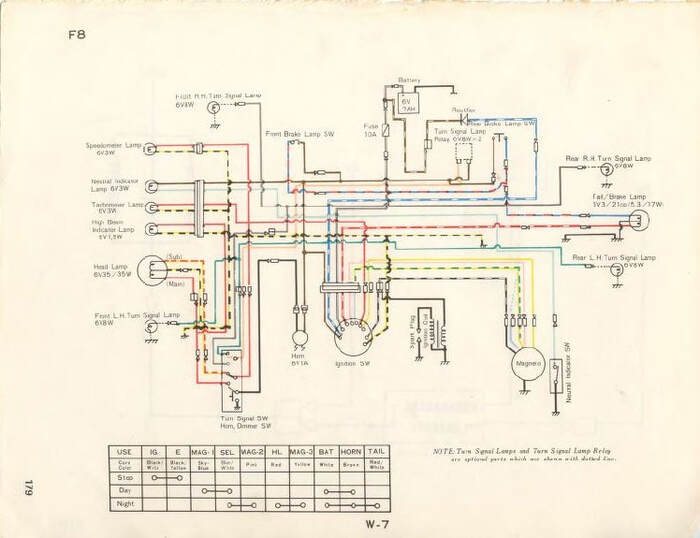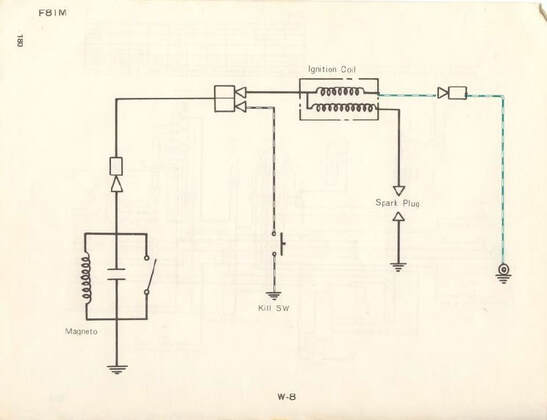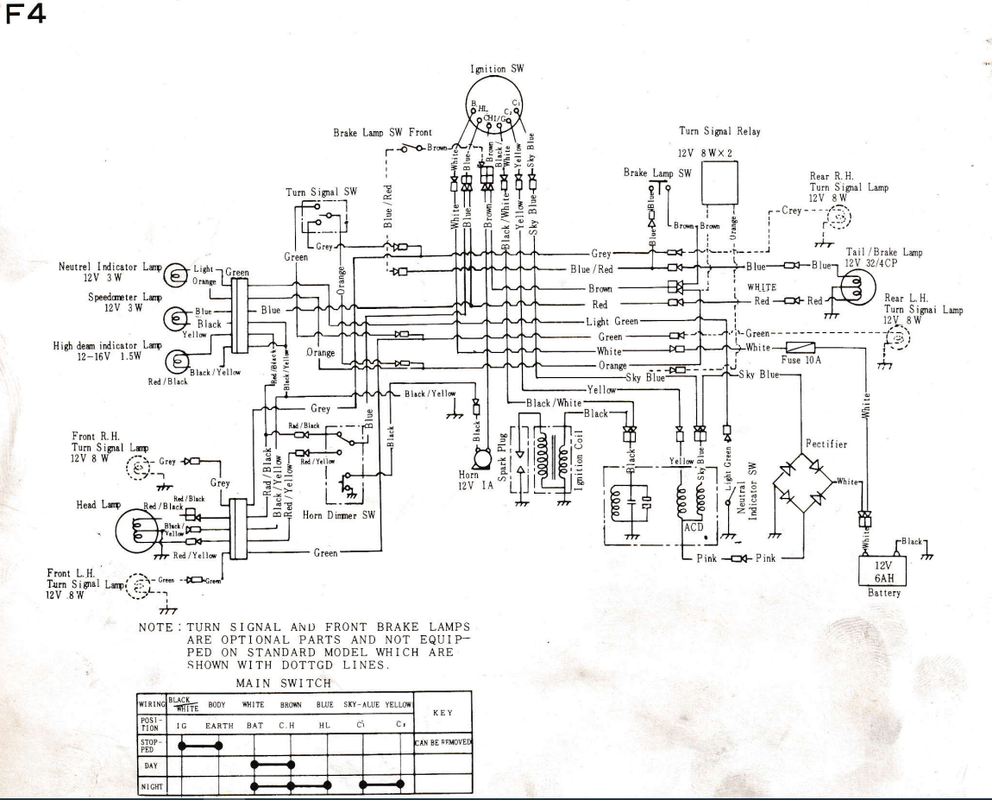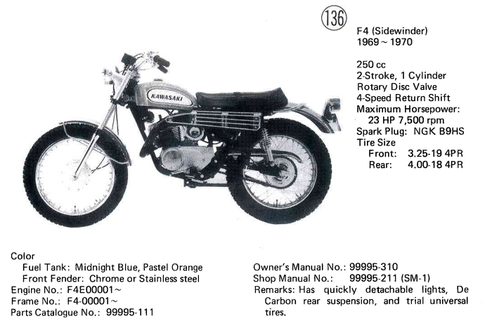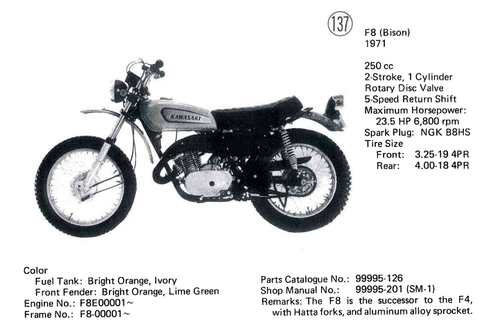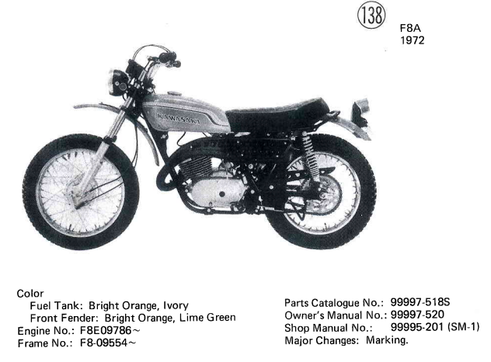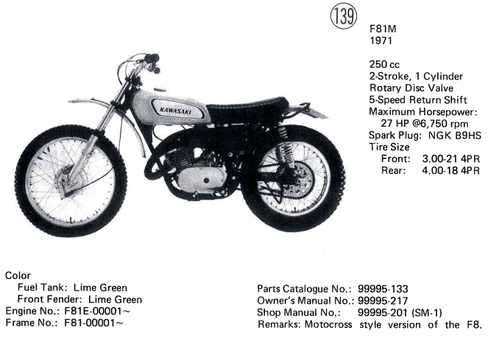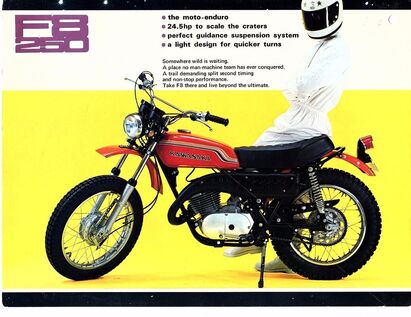 Kawasaki F8 250cc
Kawasaki F8 250cc
250 CC
F4 (Sidewinder), F21M (Green Streak), F8 (Bison), F81M (motocross)
As compared to the smaller Kawasaki rotary valve model displacements, the 250cc class is rather sparse. Models in this category had a very short run, with some being one year only models or limited production. The most recognizable model in the 250cc displacement would be the F8, which only lasted 2 model years. The other models in this displacement were rare purpose built flat track/motocross models that saw limited production. All the 250cc bikes would be replaced by piston port (and later reed valve) induction, starting in 1973 with the F11 as well as the KX250. Kawasaki would also build its first 4 stroke 250cc single in 1978 the KLR250.
The F4 (Sidewinder) and F21M both share quite a bit of engine and internals, just as the F8 and F81M share a lot of the same parts. However the two model groups do not share anything between the two. It could be considered that the F8/F81M engines are more developed and refined versions of the F4/F21M. The F8/F81M share a lot with the larger 350cc F5 & F9 engines.
Most parts on the F8 are the same except for the piston and cylinder. Fun fact! The muffler/expansion chamber on the F81M is the same one that was offered in the "Speed Kit" for the F5 (350cc) Big Horn
F4 (Sidewinder), F21M (Green Streak), F8 (Bison), F81M (motocross)
As compared to the smaller Kawasaki rotary valve model displacements, the 250cc class is rather sparse. Models in this category had a very short run, with some being one year only models or limited production. The most recognizable model in the 250cc displacement would be the F8, which only lasted 2 model years. The other models in this displacement were rare purpose built flat track/motocross models that saw limited production. All the 250cc bikes would be replaced by piston port (and later reed valve) induction, starting in 1973 with the F11 as well as the KX250. Kawasaki would also build its first 4 stroke 250cc single in 1978 the KLR250.
The F4 (Sidewinder) and F21M both share quite a bit of engine and internals, just as the F8 and F81M share a lot of the same parts. However the two model groups do not share anything between the two. It could be considered that the F8/F81M engines are more developed and refined versions of the F4/F21M. The F8/F81M share a lot with the larger 350cc F5 & F9 engines.
Most parts on the F8 are the same except for the piston and cylinder. Fun fact! The muffler/expansion chamber on the F81M is the same one that was offered in the "Speed Kit" for the F5 (350cc) Big Horn
Kawasaki Bison F8, F81m, F4, F21M Model Year Identification chart: *it is common for frame and engine numbers to mis-match
|
F8 Carburetor Settings Type- VM30SC (30mm) Main Jet - 117.5 "R" (round head) Needle Jet - 0-8 Jet Needle - 5EL 9-2 Pilot Jet - 30 Cutaway - 2.5 Air screw - 1-3/4 turns out F8M Carburetor Settings Type- VM30SC (30mm) Main Jet - 130 "R" (round head) Needle Jet - 0-6 Jet Needle - 5EH 7-3 Pilot Jet - 40 Cutaway - 2.5 Air screw - 1-1/4 turns out F4 Carburetor Settings Type- VM28SC (28mm) Main Jet - 150 (Mikuni hex) Needle Jet - 0-2 Jet Needle - 5DP 7-3 Pilot Jet - 30 Cutaway - 2.5 Air screw - 1-1/4 turns out F21M Carburetor Settings Type- VM28SC (28mm) Main Jet - 170 (Mikuni hex) Needle Jet - P-0 Jet Needle - 5D 1-2 (late 5D 1-2) Pilot Jet - 30 Cutaway - 2.5 Air screw - 1-1/4 turns out F8 Magneto ignition coil testing
1) Meter set to R x 1, connect the red lead to the black wire (going to the ignition coil) and the black lead to ground. 2) The coil is good if the value is +/- (10%) 0.5 ohm |
Wiring diagrams
F21M 1968-1970
*rare motocross model, know as Green streak 238 Engine No. 400001- Frame No. F24-0001- Kawasaki's first attempt at a 250cc motocross model. Built loosely from engine of the F2 (175cc) model, but largely a unique model that shares parts with what would become the street legal F4 Sidewinder (street scrambler). Features tuned expansion chamber exhaust & rotary valve unique to this model only. Read more here. Oiling system: Premix only 20:1 |
|
F4 1969-1970 (Sidewinder)
*detuned street scrambler version of the F21M Engine No. F4E00001- Frame No. F4-00001- Street scrambler version of the F21M. Shares some common parts, but is detuned for both street and trail use. An interesting case of a street version being developed from a "competition only" performance model. Usually it had been the other way around. MSRP: $695.00 Oiling system: Super Lube Injection |
|
F8 1971 (Bison)
*New model, Enduro styling, 2 year only model Engine No. F8E00001- Frame No. F8-00001- New model with enduro styling. Shares almost nothing with the previous F4. One of 3 models to feature the HATTA forks with adjustable front axle. Aluminum wheels, aluminum front & rear fenders. Only year to be marketed as the "Bison" Oiling system: Injecto-Lube (can NOT disable for premix use, lubricates right side crank bearing and big end rod bearing) |
|
F8A 1972
*Styling change, 2 year only model Engine No. F8E09786- Frame No. F8-09554- Last year for the F8 and the 250cc rotary valve engine. The F11 (piston port) 250cc model replaces the F8 in the 250cc class. "Bison" name removed from marketing, known just as the "F8" |
|
F81M 1971
*motocross/scrambler version of the F8 Engine No. F81E-00001- Frame No. F81-00001- Rare 1 year only model. The F81M is actually more closely related to a 1970 F5 (350cc) modified with "Speed Kit" , marketed as the Power Pack, parts. Features a 21 inch wheel, versus the F8's 19 inch. A tuned expansion chamber with stinger, that is the same exhaust that came as part of the "Speed Kit" for the F5. Same Speed Kit rear shocks and gearing. Also featured the HATTA forks with adjustable axle position. Close ratio transmission that is different than the gearing on the F8. Although billed as a motocrosser, its performance was more tailored to flat track or smoother TT style racing. Oiling system: Premix only 20:1 |



